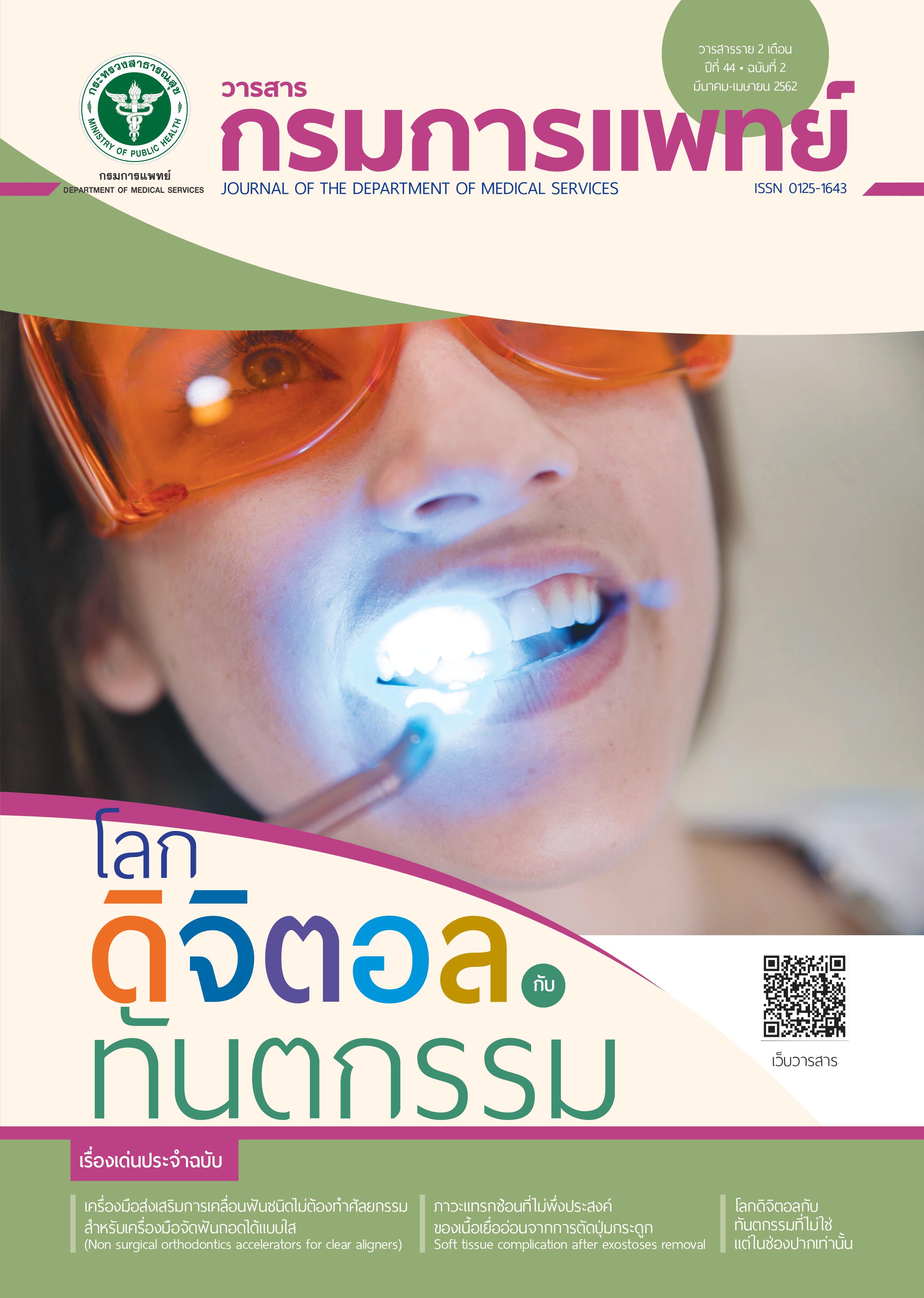Factors Associated with Patient Engagement behavior in Medication Safety in Community Hospitals
Keywords:
Patient engagement, Patient safety, Medication safety, Relationship between patient and healthcare providerReferences
Chaleoykitti S, Kamprow P, Promdet S. Patient Safety and Quality of Nursing Service. Journal of The Royal Thai Army Nurses [Internet]. 1 [cited 2May2019]; 15:66-0. Available from: https://www.tci-thaijo.org/index.php/JRTAN/article/ view/25158.
WHO. WHO PATIENT SAFETY CURRICULUM GUIDE FOR MEDICAL SCHOOLS.Retrieved fromhttp://www.who.int/patientsafety/ information_centre/documents/who_ps_curriculum_ summary.pdf .from 11:16 08 2014. 2009.
Patient- and Family-Centered Care Initiatives in Acute Care Settings: A Review of the Clinical Evidence, Safety and Guidelines. Ottawa ON: 2015 Canadian Agency for Drugs and Technologies in Health.; 2015 Aug 31.
Limpanyalert P. Engagement for Patient Safety. The Healthcare accreditation Institute (Public organization). Nonthaburi; 2015.
WHO. (2014). Global Expert Consultation on the WHO Framework on Patient and Family Engagement 27-28 October 2014: www.who.int/patientsafety/patients_for_ patient/news/global-consultation-report.pdf?ua=1
The Healthcare accreditation Institute (Public organization). Summary annual report 2015.Retrieved 20 July 2017. From https://www.ha.or.th/TH/FileDownload/ annual report 2015.
Carman KL, Dardess P, Maurer M, Sofaer S, Adams K, Bechtel C, et al. Patient and family engagement: a framework for understanding the elements and developing interventions and policies. Health Aff (Millwood). 2013; 32:223-31.
Jenifer Bresnick. Patient Engagement Must Be Top Priority for Quality Healthcare Patient engagement cannot flourish unless consumers have a simple, robust way to access their own health data to take control of their care. POPULATION HEALTH NEWS:2016 retrieved 20 March 2018. From https://healthitanalytics.com/news/patientengagement-must-be-top-priority-for-quality-healthcare
Mohsin-Shaikh S, Garfield S, Franklin BD. Patient involvement in medication safety in hospital: an exploratory study. Int J Clin Pharm 2014;36:657-66.
Kaphingst KA, Weaver NL, Wray RJ, Brown MLR, Buskirk T, Kreuter MW. Effects of patient health literacy, patient engagement and system-level health literacy attribute on patient-reported outcomes: a representative statewide survey. BMC Health Ser Res 2014; 14:475.
Jordan JE, Briggs AM, Brand CA, Osborne RH. Enhancing patient engagement in chronic disease self-management support initiatives in Australia: the need for an integrated approach. Med J Aust 2008; 189:S9-13.
Health Systems Research Institute (HSRI). Health Promotion Thesaurus 1998 revised edition. Nonthaburi; 1998.
Jindawong B. Validity and Reliability of The Thai version of Health Literacy screening Tool for Patients at Srinagarind Hospital, Khon Kaen, Thailand. Master of science Thesis in Community Health Development, Graduate school, Khon Kaen university. Khon Kaen; 2013.
Stewart AL, Nápoles-Springer AM, Gregorich SE, SantoyoOlsson J. Interpersonal processes of care survey: patientreported measures for diverse groups. Health Serv Res 2007; 42:1235-56.
Srisathitnarakul B. The Methodology in Nursing Research. Bangkok. U & I inter media; 2010.
Kim JM, Suarez-Cuervo C, Berger Z, Lee J, Gayleard J, Rosenberg C, et al. Evaluation of Patient and Family Engagement Strategies to Improve Medication Safety. Patient 2018; 11:193-206.
Lee JL, Dy SM, Gurses AP, Kim JM, Suarez-Cuervo C, Berger ZD, et al. Towards a More Patient-Centered Approach to Medication Safety. J Patient Exp 2018; 5:83-7.
Irizarry T, DeVito Dabbs A, Curran CR. Patient Portals and Patient Engagement: A State of the Science Review. J Med Internet Res 2015; 17:e148.
Ruggiero JE, Robinson CO, and Paynter N. Coordinated learning to improve evidence-based care: A model for continuing education for the new healthcare environment. Abstract presented at 2016 ACEhp Quality Symposium, September 29, 2015, Chicago, IL.
Bosworth HB, Pini TM, Walters CB, Sih-Meynier R. The future of patient engagement in the oncology setting: how practical patient engagement recommendations and innovative inter-professional education can drive change. J Participat Med 2017; 9:e7.
Martin HM, Navne LE, Lipczak H. Involvement of patients with cancer in patient safety: a qualitative study of current practices, potentials and barriers. BMJ quality & safety 2013; 22:836-42.
Downloads
Published
How to Cite
Issue
Section
License
บทความที่ได้รับการตีพิมพ์เป็นลิขสิทธิ์ของกรมการแพทย์ กระทรวงสาธารณสุข
ข้อความและข้อคิดเห็นต่างๆ เป็นของผู้เขียนบทความ ไม่ใช่ความเห็นของกองบรรณาธิการหรือของวารสารกรมการแพทย์



